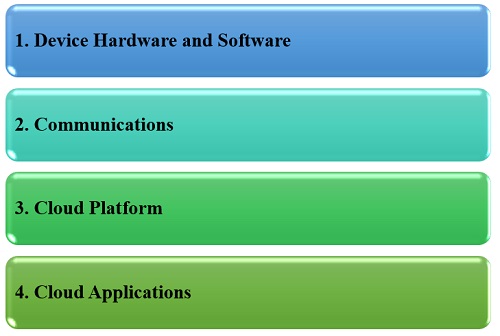Home »
IoT (Internet of Things) Tutorial
IoT (Internet of Things) Stack
IoT Stack: In this tutorial, we will learn about the IoT Stack and its fundamental layers.
By Shahnail Khan Last updated : August 12, 2023
The "Internet of Things" (IoT) is a concept that depicts how ordinary things may connect to the Internet and become smart gadgets. These objects might include your house thermostat, a fitness tracker you wear, or even manufacturing machinery. The Internet of Things has the potential to make our lives easier, improve work procedures, and increase our general quality of life.
However, realizing the full potential of IoT necessitates a complex interaction of several technologies. Let's understand the Internet of Things technological stack, which facilitates this digital revolution. Understanding what makes up this stack and how its many components interact can help us make sense of the IoT.
We typically organize the IoT stack into four fundamental layers:

1. Device Hardware and Software: The Foundation of Smart IoT Devices
i) Device Hardware
IoT devices act as a link between the physical and digital worlds. You must first determine if your product is a stand-alone gadget or an enhancement to current ones (a "brownfield" solution). Devices mostly gather data, which affects your hardware requirements. Simple data collecting may require one sensor, but sophisticated requirements may necessitate industrial-grade computers equipped with sensors, CPUs, storage, and connection. Your hardware selection depends on cost, size, and availability. It can range from modest solutions such as System on a Chip (SoC) to more powerful alternatives such as Raspberry Pi or industrial computers.
ii) Device Software
Device software links devices to the cloud, allows real-time analytics, and manages data collecting. Device software also lowers hardware development risks by enabling flexibility via "software-defined hardware." It is divided into two categories: Device Operating System (OS), which is chosen depending on IoT complexity and real-time requirements, and Device Applications, which operate on top of the OS and provide specialised features such as data acquisition and cloud connectivity.
2. Communications
Communications, often known as "connectivity," describes how your gadget connects with the outside world, including physical networks and protocols. Choosing the appropriate communication channels is critical in your IoT product strategy. Even though it occurs within the device, we refer to it as a distinct layer to better understand it. It influences not just how data travels to and from the Cloud (e.g., Wi-Fi, WAN, LAN, 4G, 5G, LoRa), but also how your device communicates with other devices, particularly in sectors such as smart buildings that rely on protocols such as BACnet.
3. Cloud Platform
IoT cloud platforms are like the super glue that holds smart devices together with the vast possibilities of cloud computing, all packaged as an end-to-end service. You could hear them referred to as Cloud Service IoT Platforms. In a world where billions of devices connect to the internet, these platforms are critical to unlocking the potential of big data received from these devices and efficiently using it for numerous purposes.
Cloud platform includes -
- End-to-end Service: IoT cloud platforms are your one-stop shop. They combine the magic of IoT devices with the wide world of cloud computing to provide a full solution. Consider it a one-of-a-kind experience from beginning to end.
- Variety of Providers: These platforms may be developed on top of major cloud services such as those provided by Microsoft, Amazon, Google, and IBM. Even network giants such as AT&T, Vodafone, and Verizon have their own IoT systems that heavily emphasise keeping your devices linked. Some platforms are designed specifically for specific sectors, such as oil and gas or logistics and transportation. Even device manufacturers are getting in on the game by providing IoT cloud platforms.
So, in a nutshell, IoT cloud platforms are your go-to answer for ensuring that all those smart gadgets out there can communicate with one another, share data, and make our lives easier and more efficient.
4. Cloud Applications
The IoT stack's top layer consists of apps and software that use data from IoT devices to deliver important insights and execute specific functions. The IoT stack's cloud application layer is all about, analytics, data management and communication. It includes simple applications for monitoring and managing IoT devices and internal device management features. This layer converts raw data into relevant insights and promotes communication through APIs, making it a necessary component of every IoT system.
The IoT technology stack, which includes everything from device hardware to apps, is required for developing and deploying IoT solutions. Understanding these levels is critical for building and implementing successful Internet of Things applications.
It's worth noting that the language and features of the IoT technology stack may differ depending on the source, but these four levels give core knowledge of how IoT systems are designed and operated.
Advertisement
Advertisement